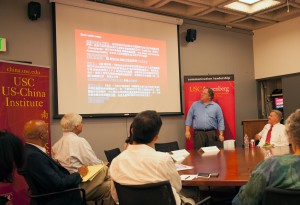Journalists debate U.S.-China summit media coverage
A panel discussion on the media coverage of the June meeting between President Barack Obama and President Xi Jinping of China took place Tuesday at the Annenberg School for Communication and Journalism.

Media Blitz · Director of the USC U.S.-China Institute Clayton Dube speaks in front of panelists about the media coverage of the widely publicized meeting between President Obama and President Xi of China. – William Ehart | Daily Trojan
The event’s panel featured School of Journalism Director Michael Parks, Interim Director of Annenberg’s Center on Communication Leadership and Policy Geoffrey Cowan and Director of the USC U.S.–China Institute Clayton Dube.
The meeting between the American and Chinese presidents, which took place at Sunnylands, Walter H. Annenberg’s Rancho Mirage, Calif. estate, included issues ranging from cybersecurity to climate change, according to Forbes.
The meeting, however, also drew incongruent coverage from both the international and domestic press and became a widely discussed topic in popular culture in the two nations.
The journalism forum focused on the treatment of the event in the media, as well as some of the behind-the-scenes details of the presidential summit.
To begin the discussion, Cowan brought up some of the failures of the American media in the coverage of the Sunnylands summit, including a New York Times article that said First Lady Michelle Obama was going to skip the event.
“Michelle Obama was never going to be there, but the fact that The New York Times wrote an article [about it] created a problem,” Cowan said.
Dube talked about why the summit was such an important meeting between two world leaders, as well as how the disparate media coverage is a concerning issue.
“In GDP, global trade, defense spending … what our two countries do matters, and this is why this meeting is important,” Dube said.
In explaining the American media’s presentation of the Sunnylands summit, Dube presented photos from various newspapers, ranging from the Los Angeles Times to the Chicago Tribune, as examples. Though several news sources paid attention to the political event, approximately half of the major newspapers Dube presented did not contain any stories about Obama’s meeting with Xi.
Dube also displayed the three largest Chinese newspapers, all of which featured the exact same stories and included the Sunnylands summit as a headline.
“The Chinese stay on message … because [they] have somebody dictating that message throughout,” Dube said.
According to Dube, a major issue with American news outlets is that they are commercialized and that the editorial process of the United States’ media focuses on maximizing the sale of news materials.
USC students had both comments and concerns on the media’s distribution of information to the American public.
“I think it’s interesting that there’s so much more media coverage of [the Sunnylands summit] in China, as if the Chinese citizens are so much more interested in the relationship between the two countries,” said Luke Phillips, a sophomore majoring in international relations and history. “In terms of having good foreign policy, the media has a large responsibility in keeping people informed as widely and as deeply as possible.”
Songyu Zhu, a junior from China majoring in history, attended the panel discussion because of her interest in social media.
“I think it’s important to also look at social media. Television and newspapers are visual images, not interactions between real people,” Zhu said. “Media can have a positive influence on people if they are offering a wide range of opportunities for people to access information. Through the media, people can learn about the two countries’ cultures and affairs.”
The discussion provided an opportunity for USC students to discuss issues of foreign policy and political affairs as well as journalism and the media in American society.
Cowan believes that all USC students should seize the opportunities that arise on campus to be a part of discussions about society and international relations.
“One of the most valuable experiences USC students have is to go to events that aren’t a part of their classroom experience,” Cowan said. “You’ll be exposed to ideas, controversies and opportunities, and those are among the most exciting things that happen on this university’s campus.”
Follow Selena on Twitter @selenaxng
